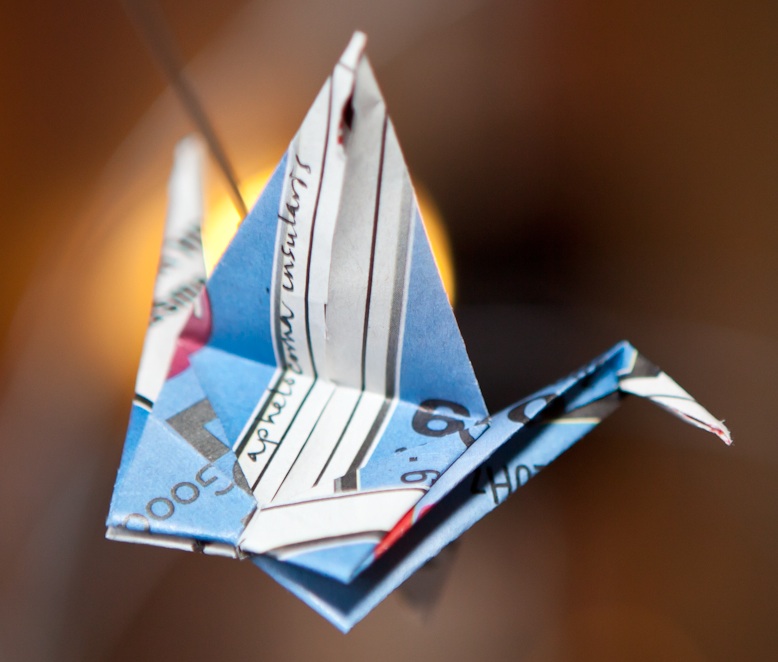 1,000 Flyers installation at Lady Eaton College, Trent University, 2020. Credit: Alyssa Diatel
1,000 Flyers installation at Lady Eaton College, Trent University, 2020. Credit: Alyssa Diatel
The space where art and environmentalism collide is a space where hearts become inspired. In the art project titled 1,000 Flyers, anyone can participate and add a contribution to the art piece, giving an opportunity for others to learn and become aware of an important environmental issue, while having a personal and meaningful interactive experience.
“1,000 Flyers is an ongoing participatory eco-art project drawing attention to threats to bird populations worldwide. There are currently over 1,400 bird species at risk of extinction globally, and this project honours and memorializes them through the intentional folding of paper cranes for each of these species,” shared Jessica Marion Barr, the founder of this project, who notes that the number of species has increased by more than 100 since the project was started nine years ago.
“There are currently over 1,400 bird species at risk of extinction globally, and this project honours and memorializes them through the intentional folding of paper cranes for each of these species,”
“Participants are asked to select an at-risk bird species from a list provided by the artist and then, in the spirit of the Japanese tradition of senbazuru (the folding of 1,000 paper cranes to aid in the healing of someone who is ill), to fold an origami crane as a prayer for the healing and survival of this species,” Barr explained.
 1,000 Flyers at the Urban Forests & Political Ecologies Conference, Hart House, Toronto (2013). Credit: Vincent Luk
1,000 Flyers at the Urban Forests & Political Ecologies Conference, Hart House, Toronto (2013). Credit: Vincent Luk
“The title of the project is a play on words – ‘flyers’ refers to the birds as well as to the material from which we make the origami; instead of traditional origami paper, we use junk mail – the flyers that appear unbidden on our doorsteps, and whose existence speaks to the threats to bird and other living populations worldwide: consumerism, factory farming, deforestation, pollution, and on and on.”
 1,000 Flyers at the Urban Forests & Political Ecologies Conference, Hart House, Toronto (2013). Credit: Vincent Luk
1,000 Flyers at the Urban Forests & Political Ecologies Conference, Hart House, Toronto (2013). Credit: Vincent Luk
Not only is the message of the art environmentally conscious, but the material that it is made of contributes to the same message. Upcycled paper is a more sustainable option that also, as Barr explained, comments on the nature of consumer culture, tying in the awareness of the threats of the birds as an integrated part of the art itself.
“Participants label their creations with their chosen species’ name and then add them to the growing ‘flock’ of 1,000 Flyers. When the project is complete and all threatened species on the list (from the IUCN Red List of Endangered Species, see www.iucnredlist.org/) have been commemorated, the piece will be displayed as a unified installation, hopefully outdoors in a tree, tying the project literally and metaphorically to existing bird habitat.”

 1,000 Flyers installation at Lady Eaton College, Trent University, 2020. Credit: Alyssa Diatel
1,000 Flyers installation at Lady Eaton College, Trent University, 2020. Credit: Alyssa Diatel
The most recent participatory installation of 1,000 Flyers occurred in March 2020 just prior to pandemic lockdowns, at Trent University’s Lady Eaton College, where the project was hosted as a part of the college’s annual Marjory Seeley Women in Leadership event. However, as an ongoing and interactive project, participants are always welcome to contribute and pay their own respects to this growing memorial for endangered birds.
 1,000 Flyers at the Urban Forests & Political Ecologies Conference, Hart House, Toronto (2013). Credit: Vincent Luk
1,000 Flyers at the Urban Forests & Political Ecologies Conference, Hart House, Toronto (2013). Credit: Vincent Luk

Siobhan Mullally (she/her) has an Honours B.E.S. from the School of Environment, Resources and Sustainability (SERS) at the University of Waterloo with a minor in English Language and Literature and two diplomas in Environmental Assessment and Ecosystem Restoration and Rehabilitation. For her senior thesis, she travelled to Labrador to study climate change impacts on tundra ecosystems in the Canadian Subarctic. As a budding ecologist, researcher, and writer, she is interested in exploring the intersections between ecology and communication to inspire climate change and help others develop a deeper appreciation for nature. In her free time, she enjoys spending time in nature and getting lost in her favourite novels.













